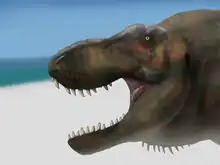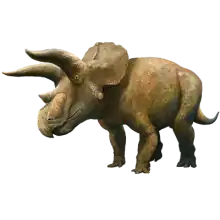| Hall Lake Formation | |
|---|---|
| Stratigraphic range: Late Cretaceous, Campanian–Maastrichtian ~ | |
| Type | Geological formation |
| Unit of | McRae Group |
| Underlies | Jose Creek Member[1] |
| Overlies | "Quaternary-Tertiary basalt flows and alluvium" |
| Lithology | |
| Primary | Mudstone, "shale", sandstone |
| Location | |
| Coordinates | 33°12′N 107°06′W / 33.2°N 107.1°W |
| Approximate paleocoordinates | 40°30′N 81°06′W / 40.5°N 81.1°W |
| Region | New Mexico |
| Country | United States |
 Hall Lake Formation (the United States)  Hall Lake Formation (New Mexico) | |
The Hall Lake Formation, formerly called the Hall Lake Member, is a geological formation in Sierra County, New Mexico preserving Lancian fauna, most notably dinosaurs. It is regarded as a member of the McRae Group, including the Elephant Butte and Staton-LaPoint locales.[2]
Description
While most estimates place it firmly within the Lancian fauna, specifically using taxa such as Compsemys as index fossils to recover a Campanian-Maastrichtian age,[3] Lozinsky et al. (1984) note the presence of basalt flows and alluvium dating to the Quaternary-Tertiary.
It overlooks the Jose Creek Member and is composed of purple and maroon shales. When they meet, it is marked by a basal conglomerate or a color distinction where conglomerate is absent. Various Cenozoic units overly the formation. Where some choose to classify these layers as a member of the McRae Formation,[4] others classify it as a distinct formation in a group of formations.[5]
Fossil content
Dinosaurs
Saurischians
Color key
|
Notes Uncertain or tentative taxa are in small text; |
| Genus | Species | Locality | Material | Notes | References | Images |
|---|---|---|---|---|---|---|
| Tyrannosauridae | indet. | Staton-LaPoint |
|
Lozinsky et al. (1984) call it indeterminate | [4] | |
| Tyrannosaurus | T. mcraeensis | Elephant Butte (upper) |
|
[6] |  | |
| Alamosaurus | sp. | upper |
|
Tentative referral | [5][4] | |
| Sauropoda | Possibly from the Jose Creek Member | [7] | ||||
| Theropoda |
Ornithischians
Color key
|
Notes Uncertain or tentative taxa are in small text; |
| Taxon | Locality | Material | Notes | References | Images |
|---|---|---|---|---|---|
| Triceratops sp. | 2 miles south of Elephant Butte |
|
This genus, Torosaurus or a novel taxon | [2][4] |  |
| Sierraceratops turneri | Elephant Butte (lower) |
|
[5] |  | |
| Ceratopsidae | Elephant Butte (upper) |
|
A new genus similar to Torosaurus is said to exist above the base of the formation | [3] | |
| Elephant Butte (lower) | Indeterminate, in abundance | ||||
| Torosaurus sp. | Elephant Butte (upper)? | ||||
| Hadrosauridae | cannot be determined | Indeterminate and of unknown origins due to faulting or Quaternary cover | |||
| Ankylosauria |
|
Possibly from the Jose Creek Member, near identical from UNM-FKK-001P of the Kirtland Formation | [7][4] |
Reptiles
| Taxon | Locality | Material | Notes | References |
|---|---|---|---|---|
| Testudinata | Elephant Butte (upper) | [2] | ||
| Crocodylia | ||||
| Compsemys | Index fossils suggesting a Lancian age | [3] | ||
| Bothremydidae |
Plants
| Genus | Species | Locality | Notes | References |
|---|---|---|---|---|
| Tracheophyta | indet. | 2 miles south of Elephant Butte | [2] | |
| Sabalites | sp. | Possibly from the Jose Creek Member | [7] | |
| Sequoia | ||||
| Sabal | ||||
| Araucarites | ||||
| Viburnum | ||||
| Cinnamomum | ||||
| Exnelumbites | ||||
| Phyllites | ||||
| Ficus | ||||
| Salix |
References
- ↑ Amato, Jeffrey M.; Mack, Greg H.; Jonell, Tara N.; Seager, William R.; Upchurch, Garland R. (2017-05-11). "Onset of the Laramide orogeny and associated magmatism in southern New Mexico based on U-Pb geochronology". Geological Society of America Bulletin: B31629.1. doi:10.1130/B31629.1. ISSN 0016-7606.
- 1 2 3 4 Vigla Formation at Paleobiodb.org
- 1 2 3 Lucas, Spencer G.; Dalman, Sebastian; Lichtig, Asher J.; Elrick, Scott; Nelson, W. John; Krainer, Karl (2017). "Stratigraphy and Age of the Dinosaur-Dominated Fossil Assemblage of the Upper Cretaceous Hall Lake Member of the Mcrae Formation, Sierra County, New Mexico". New Mexico Geological Society Annual Spring Meeting. doi:10.56577/SM-2017.479.
- 1 2 3 4 5 6 Lozinsky, Richard P.; Hunt, Adrian P.; Wolberg, Donald L.; Lucas, Spencer G. (1984). "Late Cretaceous (Lancian) dinosaurs from the McRae Formation, Sierra County, New Mexico". New Mexico Geology. 6 (4): 72–77. doi:10.58799/NMG-v6n4.72. ISSN 2837-6420.
- 1 2 3 Dalman, Sebastian G.; Lucas, Spencer G.; Jasinski, Steven E.; Longrich, Nicholas R. (2022). "Sierraceratops turneri, a new chasmosaurine ceratopsid from the Hall Lake Formation (Upper Cretaceous) of south-central New Mexico". Cretaceous Research. 130: 105034. doi:10.1016/j.cretres.2021.105034.
- ↑ Dalman, Sebastian G.; Loewen, Mark A.; Pyron, R. Alexander; Jasinski, Steven E.; Malinzak, D. Edward; Lucas, Spencer G.; Fiorillo, Anthony R.; Currie, Philip J.; Longrich, Nicholas R. (2024-01-11). "A giant tyrannosaur from the Campanian–Maastrichtian of southern North America and the evolution of tyrannosaurid gigantism". Scientific Reports. 13 (1). doi:10.1038/s41598-023-47011-0. ISSN 2045-2322.
- 1 2 3 "McRae, Sierra County, New Mexico, USA" at mindat.org